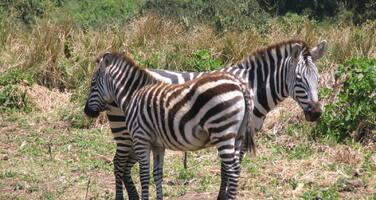Serengeti National Park
Factors affecting the property in 2002*
- Ground transport infrastructure
- Identity, social cohesion, changes in local population and community
- Illegal activities
- Impacts of tourism / visitor / recreation
- Legal framework
- Management systems/ management plan
- Water infrastructure
- Other Threats:
Threats to wildlife migration and populations
Factors* affecting the property identified in previous reports
- Poaching
- Rapidly growing human population
- Poorly designed ad-hoc tourism development projects
- Need to strengthen the coordination with the trans-border Masai Mara Reserve in Kenya
- Road project
International Assistance: requests for the property until 2002
Total amount approved : 59,500 USD
| 1999 |
Project Planning Workshop for Strengthening ...
(Approved)
Reapproval: 24 Jan, 2001 (n°1368 - 8,883 USD)
|
7,500 USD |
| 1999 | UNESCO'S Toyota LandCruisers originally destined for ... (Approved) | 10,000 USD |
| 1990 | Additional contribution towards the purchase of a ... (Approved) | 12,000 USD |
| 1989 | Purchase of a film-van and accessories for Serengeti ... (Approved) | 30,000 USD |
Missions to the property until 2002**
Conservation issues presented to the World Heritage Committee in 2002
The Centre and IUCN reported to the 25th session of the Bureau (Helsinki, December 2001) of the potential impacts on the Serengeti and Mara ecosystems posed by the proposed Ewaso Ng’iro Hydroelectric Project in Kenya, including impacts on the wildebeest migration in the World Heritage site. In this context, the importance of the Mara River Catchment to the site was noted.
As mentioned in the section of this report on the Mount Kenya World Heritage site, in November 2001 the Government of Kenya announced its authorization of forest excisions amounting to more than 170,000 acres from its remaining forests (estimated at between 2 and 10% of the country).
The Mau Forest was to lose approximately 148,000 acres (60,000 hectares) of land for human settlement. The Mau Forest is one of Kenya’s remaining moist forests, and is the watershed for the Amala River, a main tributary of the Mara River. The Mara River is key to the annual Serengeti migration, for which the site is inscribed. It has also been reported that the proposed Mau excisions will significantly affect the traditional users, the Ogiek people. The Mau Forest provides 40% of Kenya with water and five of the six major rivers flowing into the Rift Valley have become seasonal in the past few years; deforestation of the catchment is considered a major contributing factor. IUCN notes that the announced clearing of Mau Forest and associated potential impacts on the Mara River underlines the strong need for integrated catchment management and transboundary collaboration.
IUCN reiterated that there is merit in the States Parties of Kenya and Tanzania establishing a joint committee through the Commission on East Africa Cooperation Arrangement to undertake a variety of in-depth studies on the entire catchments of the Ewaso Ng’iro, Lake Natron, Mara River systems, including cost-benefit studies on the impacts of forest clearing. Such studies could also assess impacts on the Serengeti World Heritage site.
Summary of the interventions
Decisions adopted by the Committee in 2002
26 COM 21B.23
Serengeti National Park (United Republic of Tanzania)
The World Heritage Committee,
Urges the States Parties of the United Republic of Tanzania and Kenya to initiate a dialogue on the transboundary effects on the Serengeti World Heritage site from changes in the upstream catchment, and to request that IUCN, through its Regional Office for Eastern Africa, support the process leading to this dialogue.
The Committee may wish to adopt the following decision:
"The Committee urges the States Parties of the United Republic of Tanzania and Kenya to initiate a dialogue on the transboundary effects on the Serengeti World Heritage site from changes in the upstream catchment, and that the States Parties should request IUCN, through its Regional Office for Eastern Africa, to support the process leading to this dialogue."
Exports
* :
The threats indicated are listed in alphabetical order; their order does not constitute a classification according to the importance of their impact on the property.
Furthermore, they are presented irrespective of the type of threat faced by the property, i.e. with specific and proven imminent danger (“ascertained danger”) or with threats which could have deleterious effects on the property’s Outstanding Universal Value (“potential danger”).
** : All mission reports are not always available electronically.


